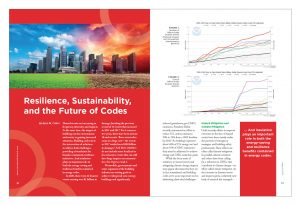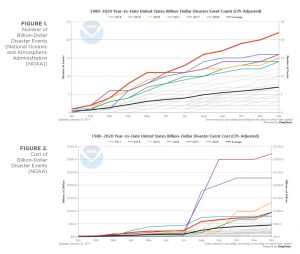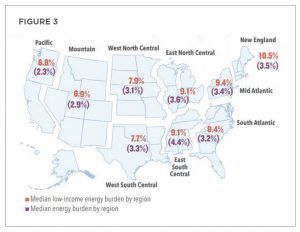Resilience, Sustainability, and the Future of Codes
Hazard events are increasing in frequency, intensity, and impacts. At the same time, the impact of buildings on the environment and society is gaining increased attention. Building codes sit at the intersection of solutions to address both challenges,
providing a foundation for broader community resilience initiatives. And insulation
plays an important role in both the energy-saving and resilience benefits contained in energy codes.
In 2020, there were 22 disaster events causing over $1 billion in damage, breaking the previous record of 16 events that occurred in 2011 and 2017. For 6 consecutive years, there have been at least 10 such events. These events also come at a huge cost—the events in 2017 totaled over $300 billion in damages.1 And these statistics do not include more localized or less extensive events that can still have huge impacts on communities. See Figures 1 and 2.
Meanwhile, governments and some segments of the building industry are setting goals to achieve widespread zero-energy buildings and significantly reduced greenhouse gas (GHG) emissions. President Biden recently announced an effort to reduce U.S. carbon emissions 50% to 52% from a 2005 baseline by 2030.2 As buildings represent about 40% of U.S. energy use3 and about 35% of GHG emissions,4 they must be addressed to achieve energy and GHG-reduction goals.
While the focus areas of resiliency to hazard events and mitigating climate change impacts may appear disconnected, they are in fact interrelated, and building codes serve as an important tool in addressing these dual challenges.
Hazard Mitigation and Climate Mitigation
Until recently, efforts to improve outcomes in the face of hazard events have been mainly under the purview of emergency managers and building safety professionals. These efforts are often called hazard mitigation. In parallel, climate scientists and others have been calling for a reduction in GHGs that contribute to climate change—an effort called climate mitigation. As the increases in disaster events and impacts grow, a relatively new body of research has emerged—attribution science—focused on determining how much of the impact can be attributed to climate change.5 As the impacts of a changing climate become increasingly visible, the climate community has recognized the need to adapt—labeling such efforts as climate adaptation.
If GHG emissions continue unabated, hazards are expected to continue to grow, establishing a feedback loop requiring ever-increasing building code requirements to reduce the risk to people and property. Given that building codes cover both the structural safety and the effective use of energy, they provide a natural forum for addressing hazard mitigation and climate mitigation.
Hazard Mitigation/Climate Adaptation and Codes
From their very establishment, building codes have had concepts of resilience at their core. Buildings are a fundamental component of communities, supporting everything from housing to education, health care to commerce. Ensuring the safety of buildings and their ability to protect occupants from natural and man-made hazards is essential. Communities cannot be resilient without resilient buildings and, thus, resilient building codes.
Research by the National Institute of Building Sciences (NIBS) and the Federal Emergency
Management Agency (FEMA) found significant benefits from the adoption of building codes. According to NIBS, regular adoption of the International Building Code (IBC) and International Residential Code (IRC) provides an $11 benefit for every $1 invested.6 FEMA found that between 2000 and 2016, the IBC and IRC provided $27 billion in cumulative benefits against flood, hurricane wind, and earthquakes. By 2040, the benefit could increase to $171 billion. If all new construction were built to modern editions of the IBC and IRC, the country would save more than $600 billion by 2060.7 Despite these impressive savings, many communities remain on older editions of the codes, not capturing the
full benefits codes provide. Sixty-five percent of communities across the country have not adopted modern building codes, and 30% of new construction is happening in communities without codes or with codes that are more than 2 decades old.8
Climate Mitigation and Codes
Since the energy crisis of the 1970s, building energy codes have focused on the effective and efficient use of energy. Today’s energy codes reflect significant improvements over time. The 2021 International Energy Conservation Code (IECC) provides an improvement of approximately 9.5% over the 2018 edition and a 40% improvement since 2006.9 It also includes a zero-energy appendix, providing communities and designers with an approach to deliver zero-energy buildings.
To continue this momentum and help communities realize their energy efficiency and GHG-reduction goals, the International Code Council (ICC) developed a new framework, Leading the Way to Energy Efficiency: A Path Forward on Energy and Sustainability to Confront a Changing Climate.10 The framework includes a new scope and intent for the 2024 IECC and beyond that assures continued improvements in energy efficiency and the inclusion of pathways to zero-energy buildings today and by 2030. The framework also recognizes the need for additional resources to support other energy-related policies like electric vehicle charging, electrification, embodied carbon, and building performance standards.
While the primary focus of energy codes to date has been on reducing energy use, a new suite of benefits is emerging—resilience benefits. The Code Council and others have identified numerous resilience benefits from energy codes, including the ability of buildings to remain comfortable during extreme heat or cold events, or when disasters knock out the electricity grid.11 Called passive survivability, this benefit reduces pressure on community shelter needs. Energy efficiency, along with on-site renewable generation and energy storage, can also reduce the need for generators and fuel storage.
Energy codes also contribute to social resilience. According to analysis by the American Council for an Energy Efficient Economy (ACEEE), low- and moderate-income households spend a significant amount of their monthly income on energy costs.12 When coupled with their higher proportion of spending on housing costs, such households often need to make tough choices that manifest in economic and social stress, further enhancing their vulnerability. See Figure 3.
With this increase in identification of co-benefits, the case for enhanced energy code development and adoption becomes clear. Naturally, as noted earlier, insulation is critical to achieving the energy-saving and resilience benefits sought from energy codes.
Building on Building Codes to Achieve Community Resilience
Building codes are a necessary component of community resilience, but additional policies and programs must be in place to achieve a truly resilient community. A community is only as resilient as its weakest link. Even with the most robust buildings, the community relies on the functioning of other infrastructure systems to remain operational. In fact, the Alliance for National and Community Resilience (ANCR) identified 19 community functions that not only make communities great places to live day to day, but also impact their resilience to shocks and stresses. These functions cover the social, organizational, and infrastructure aspects of communities. See Figure 4.
To support communities in the evaluation of their current resilience across these 19 functions, and to assist in the development of plans and investments that advance resilience, ANCR is developing Community Resilience Benchmarks (CRB) for each of the 19 community functions.13 The Buildings Benchmark covers important topics such as code adoption and enforcement, the licensure of contractors, the identification and mitigation of critical facilities and highly vulnerable structures, and the availability of incentives to go beyond minimum code requirements.
To the extent practical, the CRB rely on existing standards and resources, and help support existing resilience planning tools including the Community Resilience Planning Guide for Buildings and Infrastructure developed by the National Institute of Standards and Technology (NIST).14 Recognizing that communities are on different pathways to achieving resilience, the CRB provides a tiered approach including essential, enhanced, and exceptional requirements. As communities identify increasing levels of risk, their requirements under the benchmarks will adjust accordingly.
The Future of Codes
Building codes are designed to address risks. As risks change, building codes must adapt to address them. Climate science tells us that the climate of the past is not necessarily the climate of the future. However, most building codes are based on historical events to determine risk. Codes must adapt to address the changing climate, but the path forward is not simple. Climate models are typically done at the regional scale and not with the granularity necessary for project-level decision making. At the same time, the climate predictions can change over the life of the building due to numerous factors (not the least of which is how well we succeed with climate mitigation). Finally, building codes generally rely on authoritative sources of data that can be presented in the forms of maps or tables.
While many organizations—including the ICC, NIBS, American Society of Civil Engineers, U.S. Department of Defense and other federal agencies, New York City, and South Florida—have recognized these needs, a consistent approach has yet to emerge. To help chart a path forward, the Code Council and code development and research bodies from Canada, Australia, and New Zealand have come together to form the Global Resiliency Dialogue (Dialogue).15 The Dialogue is focused on identifying potential approaches for incorporating climate risk in codes and standards, and the common research needs for effective implementation.
As the first step in its efforts, the Dialogue released a paper, “The Use of Climate Data and Assessment of Extreme Weather Event Risks in Building Codes around the World.” The paper includes an analysis of how codes from the four Dialogue countries—plus Germany, the Netherlands, Norway, and Japan—currently use climate data. In many cases, the underlying climate data is only updated on an as-needed basis—on average, every 10 years or so.
The second effort of the Dialogue is to identify potential approaches to incorporate climate risk into building codes and standards, the underlying research need, and policy decisions necessary to implement such approaches. Dialogue participants surveyed numerous stakeholders in each country, and the organization is in the process of compiling results.
The first two efforts will culminate in the development of International Resilience Guidelines—a framework for addressing climate risk that can support codes and standards development and climate adaptation in countries across the globe. The Code Council will use the guidelines as the basis for developing strategies consistent with the I-Codes.
While not yet forward looking, the codes have started to adapt to recognize climactic changes. For example, the 2021 IECC features a new climate zone map from ASHRAE Standard 169-2013 that accounts for warming climates. The map includes a new tropical climate zone 0 and reassigned climate zones for approximately 400 of the 3,000 counties—most to warmer climate zones.16
Conclusion
Modern building codes were developed to address a growing risk in industrializing and bustling cities—the spread of fire. Since then, codes have expanded to address other risks. As new risks emerge, building codes must continue to ensure that building occupants remain safe. Today, that means responding to a changing climate and providing tools—such as insulation—to address the sustainability and resilience goals of communities.
References:
- NOAA, National Centers for Environmental Information, U.S. Billion-Dollar Weather and Climate Disasters (2021). www.ncdc.noaa.gov/billions/, DOI: 10.25921/stkw-7w73
- White House. FACT SHEET: President Biden Sets 2030 Greenhouse Gas Pollution Reduction Target Aimed at Creating Good-Paying Union Jobs and Securing U.S. Leadership on Clean Energy Technologies. April 22, 2021.
www.whitehouse.gov/briefing-room/statements-releases/2021/04/22/fact-sheet-president-biden-sets-2030-greenhouse-gas-pollution-reduction-target-aimed-at-creating-good-paying-union-jobs-and-securing-u-s-leadership-on-clean-energy-technologies/. - U.S. Energy Information Administration, “Frequently Asked Questions (FAQs): How much energy is consumed in U.S. Buildings?” www.eia.gov/tools/faqs/faq.php?id=86&t=1.
- U.S. Energy Information Administration Monthly Energy Review, Tables 11.1 to 11.6, July 2020.
- National Academies, Attribution of Extreme Weather Events in the Context of Climate Change, 2016.
- NIBS, Natural Hazard Mitigation Saves: 2019 Report, www.nibs.org/projects/natural-hazard-mitigation-saves-2019-report.
- FEMA, Building Codes Save: A Nationwide Study, 2020,
www.fema.gov/sites/default/files/2020-11/fema_building-codes-save_study.pdf. - Ibid.
- Pacific Northwest National Laboratory, Preliminary Energy Savings Analysis: 2021 IECC for Residential Buildings, 2021. www.energycodes.gov/sites/default/files/documents/2021_IECC_PreliminaryDetermination_TSD.pdf.
- www.iccsafe.org/energy
- ICC, “The Important Role of Energy Codes in Achieving Resilience,” 2019, www.iccsafe.org/wp-content/uploads/1918078_GR_ANCR_IECC_Resilience_White_Paper_BRO_Final_midres.pdf
- ACEEE, “How High Are Household Energy Burdens? An Assessment of National and Metropolitan Energy Burdens across the U.S.,” 2020, www.aceee.org/research-report/u2006.
- ANCR, Community Resilience Benchmarks, www.resilientalliance.org/the-benchmarks/
- NIST, Community Resilience Planning Guide for Buildings and Infrastructure, 2015. www.nist.gov/community-resilience/planning-guide. See also: ANCR, Using the ANCR Community Resilience Benchmarks with the NIST Community Resilience Planning Guide, 2020. www.resilientalliance.org/wpcontent/uploads/ANCR_Community_Resilience_Benchmarks_and_NIST_RPT_FINAL_LORES_compressed_1.pdf.
- Global Resiliency Dialogue, www.globalresiliency.org.
- ASHRAE, ANSI/ASHRAE Standard 169-2013, Climatic Data for Building Design Standards, 2013, www.ashrae.org/technical-resources/bookstore/weather-data-center.




